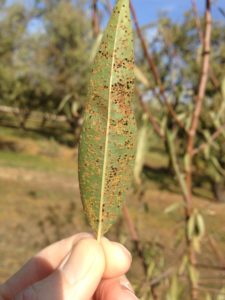Written by David Doll (UCCE Merced County) and Brent Holtz (UCCE San Joaquin County)

The foliar disease rust caused by the fungus Tranzschelia discolor has been a major problem this year. This disease is characterized by rusty-brown- or black-colored spores that form on the lower side and angular chlorotic (yellow) lesions on the upper side of the leaf. Rust can spread easily from orchard to orchard with wind, and minimal periods of leaf wetness are required for the pathogen to infect. This past year, long periods of conducive conditions, which include warmer temperatures, late spring rains, and increased canopy humidity were experienced, making rust management a challenge.
Rust is easily controlled by properly timed fungicides. Several modes of action provide protection. Those with the highest activity are FRAC Groups 3, 11, and 19 or mixtures of these groups. Also several broad-spectrum fungicides such as micronized sulfur (M2, microthiol) and chlorothalonil (M5, Bravo) have very good efficacy with short- and long-residual activity, respectively. Since rust can infect from spring to summer, sprays need to be timed accordingly. Spring sprays (2-5 weeks after petal fall) based on monitoring for rust symptoms is often used to initiate rust control practices at the beginning of a potential epidemic. One fungicide application, however, may not provide effective control if favorable conditions persist and later sprays may be needed. Typically, spring-time disease management programs for scab and Alternaria leaf spot will also provide management for rust.
High populations of rust can prematurely defoliate trees. As the fungus spreads, it ruptures leaf tissues, reducing the photosynthetic potential of the leaf, and eventually causes leaves to fall. If too many leaves fall from the tree, the tree will re-leaf, reducing the cropping potential for next year. Although this re-leafing is concerning, it is better for the tree to re-leaf than not to grow at all.
Rust overwinters on leaf tissue. This includes infected leaves remaining on the trees, or debris that is stuck in the crotches of the trees or on the ground. The increasing almond “footprint” in California agriculture and the ability of the fungus to be easily disseminated, however, means that an area-wide approach would be required for this strategy to work. Furthermore, with numerous varieties currently being cultivated, many hold their leaves until late fall and even until winter; whereas others leaf out early providing susceptible tissue during early spring rains. This situation is commonly seen in the mid- to southern almond production regions of the state where winter conditions are mild.
The pathogen can only develop on living tissue. A common practice in attempts to expedite leaf fall of healthy leaves before they become infected is to apply a high rate of zinc (30-45 lb per acre of zinc sulfate) to the trees in the early fall. This is different from a foliar fertilization as it is a higher rate intended to cause phytotoxicity and defoliation. This practice has been part of the UC Guidelines. Experience by the authors over the last few years, however, suggests that this practice is ineffective and therefore, is no longer suggested as a general strategy for rust management. Our rationale includes:
- Zinc applications are often made too late to cause effective defoliation;
- Warmer fall temperatures or increased tree vigor has made these applications less effective;
- Increasing footprint of almonds and lack of consistent area-wide sanitation practices reduces the efficacy of these treatments because residual pathogen populations move rapidly from un-sanitized orchards;
- Defoliating trees too early may reduce carbohydrate reserves, impacting next year’s crop.
In contrast, the money used for this application should be budgeted for an additional late spring or early summer spray targeting this disease. This most likely will be more effective in reducing pathogen populations, leading to a healthier orchard.

